9 November 2007 Regine bioart other reports
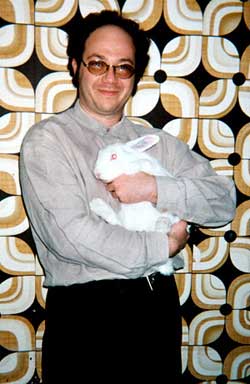 I've just spent four fascinating days at the Ecole d'Art d'Aix en Provence where a whole week of lectures, screenings and workshops are being dedicated to De l'objet de laboratoire au sujet social (From Laboratory Object to Social Subject). We explored the social, cultural and ethical issues regarding the living, human behaviour, human/animal/machines relationships and bioart.
I've just spent four fascinating days at the Ecole d'Art d'Aix en Provence where a whole week of lectures, screenings and workshops are being dedicated to De l'objet de laboratoire au sujet social (From Laboratory Object to Social Subject). We explored the social, cultural and ethical issues regarding the living, human behaviour, human/animal/machines relationships and bioart.
Yesterday morning we went to the Fondation Vasarely to listen to Eduardo Kac.
Kac is often reduced to Alba, but while his presentation was leading us through some of the highlights of his 27 year long career, i realized that there's so much more than a GPF rabbit behind his name.
In the '80s, most of his works were of the performance kind and his main interests were (and still are) literature and poetry. In 83, he created some holographic poetry, and later on explored digital poetry then biological poetry. All the possible dimensions of communication are explored in his work.
The holograms translated his interest for the visual dimension of the words. With them he was trying to create an experiment of language destabilization.
In 85 he started to get interested in networked communication, the one that came before the web. The first networked medium he used was that good old minitel which made him realize how he could create anything anywhere and show it to anyone anywhere. His creation became immaterial.
The minitel work was called Reabracadabra, kabalistical dimension. He also worked with videophones, faxes, tvs, etc. Introducing a bidirectional process in a process which is usually purely mono-directional (tv, fax). Ex. Retrato Suposto - Rostro Roto (Presumed Portrait -- Foul Face).
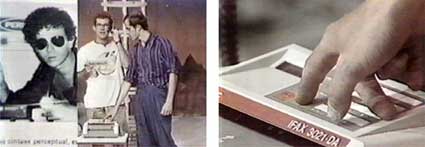
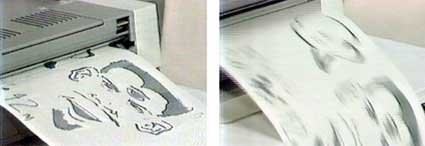
He found that distant communication is limited because it reduces the communication between humans to an exchange of sounds and images on a small and flat surface: the screen. The presence of the body is missing.
1986, searching for new forms of presence, he proposed the art of the telepresence which is, according to him, the contrary of a phone call (i'm in Chicago, you are in Aix en Provence). With telepresence you are still in Aix but you feel like you are in Chicago. There are tangible, physical consequences in that distant space of the acts i do here.
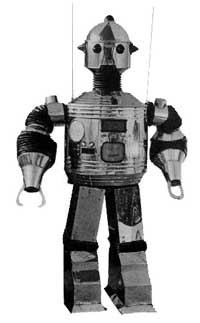
Ex. RC Robot, an anthropomorphic robot controlled by radio.
Then came a second robot, very different from the previous one. It was not anthropomorphic and whether the first one was nearly 2 meters high this second one was very close to the ground. He called it Ornitorrinco. Being so low, its point of view was more similar to the pne of an animal or of a kid. Art can suggest this kind of change of perspective. People could remotely access the fully mobile and wireless robot and alter the remote location (teleoperation) via the telephone network.
In 1996, another work of telepresence, Rara Avis. Gallery visitors and remote participants could interact with an aviary containing 30 birds from the point of view of a robotic macaw. Phenomenological video.
By wearing the headset, the viewer was transported into the aviary and perceived the aviary from the point of view of the robotic bird. When the viewer moved his or her head to left and right, the head of the telerobotic macaw moved accordingly. The real space was immediately transformed into a virtual space. The installation was connected to the Internet. Remote participants could observe the gallery space from the point of view of the telerobotic bird too. They could also use their microphones to trigger the vocal apparatus of the telerobotic bird in the gallery.
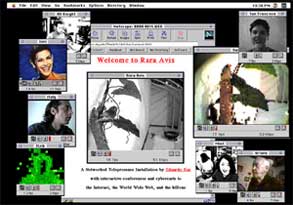
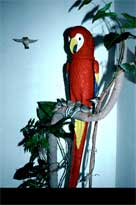
By enabling the local participant to be both inside and outside the cage, this installation created a metaphor that revealed how new communications technology enables the effacement of boundaries at the same time that it reaffirms them.
At the time, museum and galleries didn't have internet so Eduardo had to bring internet physically, he came with cables, creating transformations instead of only suggesting them. It's with this work, with Rara Avis, that he starts to explore relationships with the living, that he starts to mix the dimension of the living and the dimension of the non-living.
1994, Essay Concerning Human Understanding was the first work that have him engage with the living. He was asking the question (which at the time sounded a bit ridiculous): "Is there a sense of aesthetics in the non-human world?" We always refer to art in relationship with human beings. Art is made by men for men. Could it be possible to create art for non-human species? And if it is possible what would the impact of art for non-human have on Art?
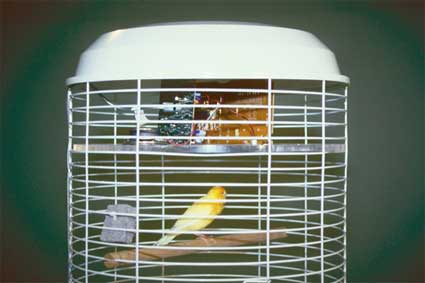
In Kentucky, a yellow canary was given a large cage, on top of which circuit-boards, a speaker, and a microphone were located. A Plexiglas disc separated the canary from this equipment, which was wired to the phone system. In New York, an electrode was placed on a plant's leaf to sense its response to the singing of the bird. The microvoltage fluctuation of the plant was monitored through a computer running a software called Interactive Brain-Wave Analyzer, a program designed to inspect the vital activity of an organism generally understood as devoid of consciousness. The information coming from the plant was fed into another computer, which controlled a MIDI sequencer. The electronic sounds themselves were pre-recorded, but the order and the duration were determined in real time by the plant's response to the singing of the bird.
Teleporting in an Unknown State (currently part of the retrospective exhibition of his work in Valencia, Spain). Plants are kept in a dark room. Through a video projector suspended above and facing the pedestal, remote participants send light via the Internet to enable this plant to photosynthesize and grow in total darkness.
The biological connection goes beyond the living or the non-living, the local and the distant, the human and the non-human.
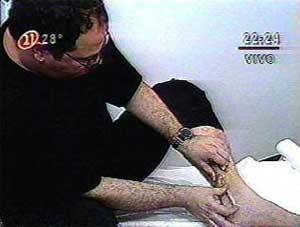
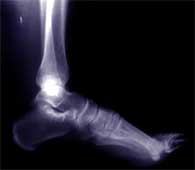
The 1997 work Time Capsule constitutes a turning point in Eduardo Kac's career. He inserted a microchip under the skin of his ankle (he still has the microchip implanted). Presence of the digital dimension inside the human body. It's the kind of microchip that pet owner use for identification and recovery of lost animals. Eduardo registered himself both as dog and dog owner. The chip is still under his skin.
It's also the year when he starts to work on his project to create a transgenic dog, K-9.
He then went on developing transgenic art, using techniques from molecular biology and genetic engineering to create living being in an artistic context. Instead of a dog he ended up creating the GFP rabbit.
The first transgenic work he created is called Genesis and starts with an extract from the Bible:
Let man have dominion over the fish of the sea, and over the fowl of the air, and over every living thing that moves upon the earth.
It was chosen for what it implies about the dubious notion of humanity's supremacy over nature.
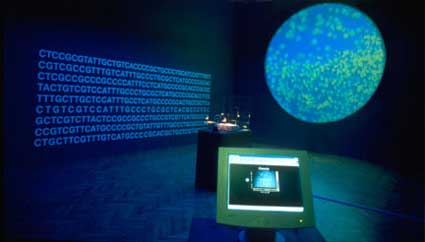
He translated the sentence in morse code and then elaborated a simple conversion principle to translate the morse into DNA base pairs, using a system he invented and which is based on the four letters TCAG which represent the 4 chemical bases. From the sequence of letters, he had a laboratory produce a gene which was sent to the artist via FedEx. It looks like a white powder. Seeing genes out of a body makes you realize that genes on their own cannot do anything. One cannot talk of life by limiting it to the genetic context.
The Genesis gene was incorporated into bacteria. Participants on the Web could turn on an ultraviolet light in the gallery, causing real, biological mutations in the bacteria. This changed the biblical sentence in the bacteria. After the show, the DNA of the bacteria was translated back into Morse code, and then back into English.
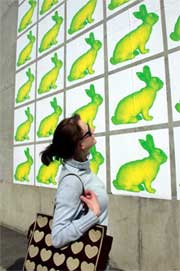 He compared the work to a computer (input/output) and to the Rosetta Stone.
He compared the work to a computer (input/output) and to the Rosetta Stone.
In 1997, he gets the idea of creating a fluorescent mammal, a chimerical animal that does not exist in nature. He is allergic to cats so he decides to use a rabbit. The rabbit looks like an albinos in day time but in the dark and using a blue light, the animal becomes green fluorescent.
It was created in 2000 with the help of a French research laboratory which censored the rabbit and refused to let Eduardo keep it. The artist then starts a campaign to liberate the rabbit and have it live with him in Chicago. My favourite action is the Alba Flag (2001) which he installed in front of his house to mark her absence.
2000 was a rather trubled year, people in France were still talking about the infected blood scandal , the mad cow disease, people were afraid of a future made of cloning and health uncertainties, digital doomsday, etc.

The press jumped on the story but was actually more interested in the conflict between the lab and Eduardo than in the project itself.
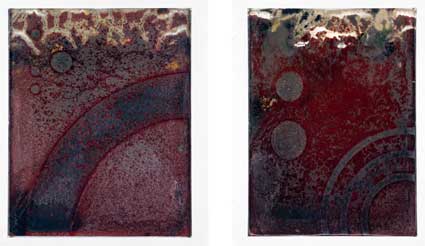
Hullabaloo and Oblivion
Specimen of Secrecy about Marvelous Discoveries is one of Kac's latest works. For the series, the artist made some "biotopes", living pieces that can be hanged on the walls of a gallery like a painting. Except that the works are living, they change during the exhibition in response to internal metabolism and environmental conditions, their exoskeleton is the frame. They are both subjects and objects. Each of them constitutes a self-sustaining ecology comprised of thousands of very small living beings in a medium of earth, water, and other materials. If you provide them with light and water, their color explode. The rabbit never left the laboratory but the bacteria of Kac's Specimen of Secrecy about Marvelous Discoveries could leave the lab, they are pet bacteria.
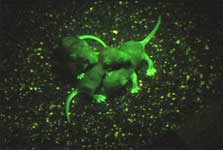
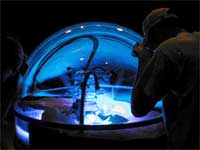
The Eighth Day investigates the fluorescent creatures that are being developed individually in laboratories The Eighth Day presents them as a new ecology that brings together living transgenic life forms and a biological robot (biobot) in an environment housed under a Plexiglas dome, thus making visible what it would be like if these GFP plants, GFP amoeba, GFP fish, and GFP mice would in fact coexist in the world at large.
A biobot is a robot with an active biological element within its body which is responsible for aspects of its behavior. It has a colony of GFP amoeba called Dictyostelium discoideum as its "brain cells".
One of the objectives of the work is to demonstrate the the future of humanity is not limited to the traditional reproduction system. ANd that won't make them less human than we are.
Kac nevertheless insisted on the fact that The Eighth Day is his last GFP work because he doesn't want to become the Yves Klein of the green colour.
Eduardo is currently having a big solo exhibition at the Instituto Valenciano de Arte Moderno (IVAM), Valencia in Spain (runs until November 11).